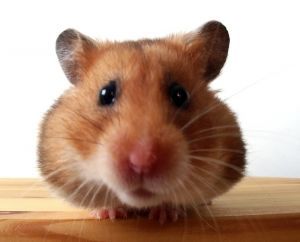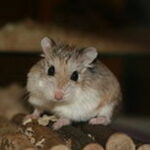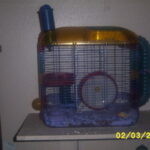The Syrian Hamster, discovered almost 200 years ago Hamsters are one of the most popular pets for children because they are relatively easy to care for. If you’ve never owned a hamster before there are some things you should know about the breed. Although hamsters don’t require much care they do require responsibility. As with any pet, hamsters need to be properly cared for in order to sustain a Happy, full life. Here are some tips on choosing a hamster, setting up a habitat, and caring for your new furry friend.
Choosing a Healthy Hamster
Most local pet stores and commercial chains carry Syrian Hamsters. Walk into any pet store during the middle of the day and it is likely all the hamsters will be asleep. Syrian hamsters are nocturnal and generally sleep most of the day. The best way to buy a hamster is to shop at night. By the time the sun goes down, Syrian hamsters are just waking and preparing for their day. By shopping at night you will get a better idea of which hamsters are healthy and which are not.
Because pet stores are often breeding grounds for disease and parasites you should pay particular attention to the health of the hamsters for sale. Hamsters that shiver, sneeze, hide, have runny eyes or nose, and do not want to be handled may be sick. It is not unusual for pet store hamsters to be infected by communicable diseases. Chances are, if one hamster is sick and being housed with other hamsters (especially when young) there is a good chance the rest of the hamsters may be ill as well. Look for hamsters that are caged individually and have a perky, alert outlook.
Avoid Syrian hamsters that have trouble breathing, do not want to be handled (may be shown in biting), those with matted or dirty fur, wet tail, those with cuts or patches of fur missing, or otherwise appear to be sick. Make sure to ask when the hamsters arrived at the store or when they were bred. Hamsters bred at the location may be pregnant without you knowing it, sometimes it is hard to tell. Syrian hamsters have one of the shortest gestation periods lasting only 4 days. You don’t want to have your hamster home a few days only to discover that she has given birth to 10 or more babies. Hamsters that have been shipped are less likely to be pregnant but may have other health problems due to over breeding and crowding.
If the hamsters have been in the store for more than 2 weeks find out how often the cage is cleaned, the food and water are changed, and if the hamsters are getting daily exercise. Don’t buy more than one hamster figuring they can live in the same habitat. In the wild Syrian hamsters do not like company and will fight to defend their territory. Fighting among hamsters can lead to infections and abscesses of the skin which can be harmful to their health.
Setting up a Habitat
Hamsters should be caged alone and should not be forced to share their habitat with any other animal. Syrian hamsters are solitary animals and should not be caged with each other, with mice, or any other small rodents. Because hamsters are nocturnal their habitat should be located in a relatively quiet, dim room that is warm. If you have a cat in your home be especially careful where you keep your hamster and what type of cage is it housed in. Cats can get hamsters and other small rodents out of wire cages, even if the openings seem small and impossible to pass. For the safety of your hamster cats should not be allowed into the room where it is kept. If you don’t own a cat, a wire cage is fine. If you prefer you can use a glass aquarium, but be aware you will need to provide something for climbing on.
When housed in wire cages, Syrian hamsters tend to scale the walls, clinging to the bars with their hands and feet. Syrian hamsters like to climb and if using a glass aquarium you will need to provide them with something to climb on. For glass aquariums try gluing some wood dowels on the inside walls of the tank using non toxic glue. Place the wood dowels horizontally and vertically to provide an ample challenge for climbing.
Bedding
The bedding inside the hamster cage should be absorbent, non toxic, and allow some room for burrowing. Avoid pine and cedar bedding because it causes respiratory irritation in hamsters. You should also avoid any bedding made from plastic because if ingested by your hamster they could become sick, or die. Try Cell Sorb Plus as a bedding. It is a super absorbent recycled paper bedding that can last 2-3 weeks at a time. Cell Sorb Plus is biodegradable, non toxic, soft, fluffy, and flushable. Not every pet store carries this brand of bedding but it is available. To find Cell Sorb Plus try looking at Pet Supplies Plus or Pet Smart. Add about 2 inches of bedding to cover the entire bottom of the cage and provide enough material for adequate burrowing.
Areas of the habitat that are used for deification and urination should be cleaned daily. To make cleaning easier, place a paper towel under the bedding to absorb excess moisture and make clean up a breeze. When using a paper towel under the bedding, the area that is soiled can be removed easily without disturbing the rest of the habitat. Syrian hamster generally only use one area inside their habitat for going to the bathroom. When that area is soiled pick up the paper towel lining from both sides, fold in half, lift out and throw away. Replace with a fresh paper towel and clean bedding. Always wash your hands after cleaning the habitat or handling your hamster.
Do not use harsh chemicals to clean your hamsters habitat. After the bedding has been removed use a natural cleaner like a lemon juice and water spray to clean the walls and bottom of the tank. Chemicals may leave lingering odors that can be harmful or fatal to your hamster.
Exercise
Inside the habitat you should also provide a nesting box and some form of exercise. In the wild, Syrian hamsters burrow and sleep during the day, and at night are active in searching for food. In a habitat there is no search for food but exercise should be provided. A hamster wheel that has a solid surface, not bars is the best. The commonly found wire wheel can be dangerous to your hamster causing injury. Because hamsters are so active at night choose a wheel that does not make noise as it is turning. Be sure the bedding is not impairing the movement of the wheel. Choose a large wheel for your Syrian hamster so they are comfortable using it. Outside of the cage you may also allow your hamster to roam around in a hamster ball. Make sure it is large enough to be comfortable for use by your Syrian hamster.
Chews
Because Syrian hamsters teeth are constantly growing make sure you provide ample chew toys. Empty paper towel and toilet paper rolls are great for hamsters to chew on, as well as some cardboard, wood chips, or a cuttle bone (generally for birds, but hamsters enjoy them too). Allowing your hamster a chew will help keep their teeth sharp and healthy. Also provide a water bottle and sturdy food bowl that cannot be knocked over.
Feeding Your Hamster
Like any other pet, hamsters need fresh food and water daily. Commercial pellet diets may not be the healthiest option for your Syrian hamster. In the wild, hamsters seek out grains, nuts, fruit, vegetables, and the occasional insect. Try to mimic their natural diet by providing plenty of whole grains, seeds, fruits, and vegetables. You can also give your hamster Monkey Chow, an occasional dog or cat treat (increases protein in hamsters diet), and clean, fresh cut grass. Do not feed your hamster the grass from your backyard; it may have pesticides that can be harmful. If you want to offer fresh grass use a cat grass that can be grown indoors in a pot or dish. Cat grass can be purchased at many commercial pet stores.
Although hamsters sleep most of the day, they do wake every 2-3 hours to hoard some food and get a bite to eat. Provide fresh food and water each morning. Most Syrian hamsters do not eat more than 1-2 tablespoons of food each day so a small handful should be sufficient. It’s better to give more food than not enough because like many animals Hamsters diets fluctuate randomly. Some days your hamster will eat more than others.
Life Expectancy and Illness
Most breeds of hamsters sold in pet stores live to be 2-3 years old. There are some Syrian hamsters that have been documented to live up to 4 years with the ability to continue breeding. Because the hamster life span is so short it is important to get regular veterinary checkups. Unless your hamster is sick, a visit to the vet once every 6-8 months should be adequate. If your hamster becomes lethargic, looses its appetite, begins sneezing or shivering you should take them to the veterinarian immediately. Generally most hamsters live a healthy life without sickness, but it can occur. If your hamster develops “wet tail” it is likely they will die soon. Hamsters can also be affected by a number of parasites, mites, and environmental irritations. Do not smoke or use air freshener around your hamster.
Handling your Hamster
Because hamsters are nocturnal they should only be handled at night. Do not take your Syrian hamster out of the cage during the day or wake them from sleep. Often, when handled during the day hamsters have been known to bite. By about 8pm your hamster should be ready to play. Hamsters are very docile creatures that don’t mind being held and petted. When holding your hamster have a firm grip but do not squeeze them because they may be frightened and bite you or defecate. Do not allow your hamster to free roam around the house because they may burrow under furniture or run and hide. By following these suggestions, your hamster can live a happy and healthy life.








